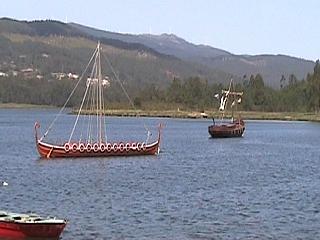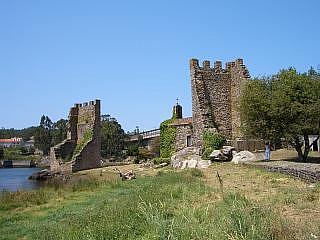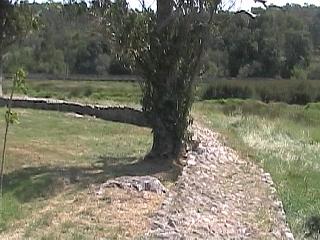The Towers of the West (Torres de Oeste) Catoira
We came across Catoira and the "Towers of the West" almost by accident as we headed inland having visited Rianxo in the ria de Arousa.

Earlier I had noticed a picture of two towers in a guide book and thought I spotted something similar beneath us as we drove over a bridge near Oeste. We pulled up, turned the car round and headed back, but again thwarted by the Galician absence of tourist signs, it took us another 10 minutes to find the road that ultimately led us under the bridge to both the towers and the waters edge. Above and right, the bridge that now spans the river and fortress of Catoira.
Vikings and Catoira
The first thing we noticed when got to the towers was the presence of two Viking long boats on the water, and we wondered if they had anything to do with a festival we had noticed taking place in Oeste. Apparently they did and we learned that a day or two earlier the boats had been involved in a reenactment of a Viking landing from the 12th century.See below.

Leaving the boats to one side, the Towers of the West (which sound like something from the Lord of the Rings) are now hidden under a large, several hundred metre long, bridge - this is partly why we struggled to spot them. That said, the view you get of them is not diminished once you are at ground level and they are also well serviced by a parking area and long elevated boardwalk. The boardwalk, if you follow it, takes you to a pick nick area and another car park a short distance away.
Below, a view of the Towers of the West with the river behind them. You can just make out the small steeple of the chapel between them.

The towers at Catoira are actually quite impressive and one stands only metres away from the waters edge. If you start walking along the remains of the ancient wall that connects the towers you quickly realise that the ruins of the wall are continuous. They loop all the way around the immediate area forming what must once have been a castle stronghold. One unfortunate observation I made, was that the access road to the towers had clearly involved the removal, or flattening, of a section of wall at the point where it intersected with the road.
The history of Catoira's Towers of the West
Below, what is left of the once grand walls that surrounded and protected this ancient medieval settlement.
Although all that remains today are the two towers, a connected chapel and the demolished footings of a grand wall, this fortress settlement was once as important as any in Spain.

Originally a small settlement was constructed around a hill fort (10 B.C. approx) and in the following decades, and Roman occupation, this evolved in to a place of commerce with a harbour and an economy based on trading. There is also a claim that the boat carrying the remains of St. James must have passed Catoira on route to Padron and some say it even ported there. But this is not how the towers claimed their place in history.
In the ninth century, attacks from the Vikings were constant along the coast and ocean fed tributaries of Europe, and Catoira was located in a key position.
If the Vikings could be repelled at this point, "Iria Flavia", Santiago and the rest of what is now Galicia were safe, if they could not, the whole of Galicia would fall as the Vikings headed inland up the Ulla river.

Click to continue

